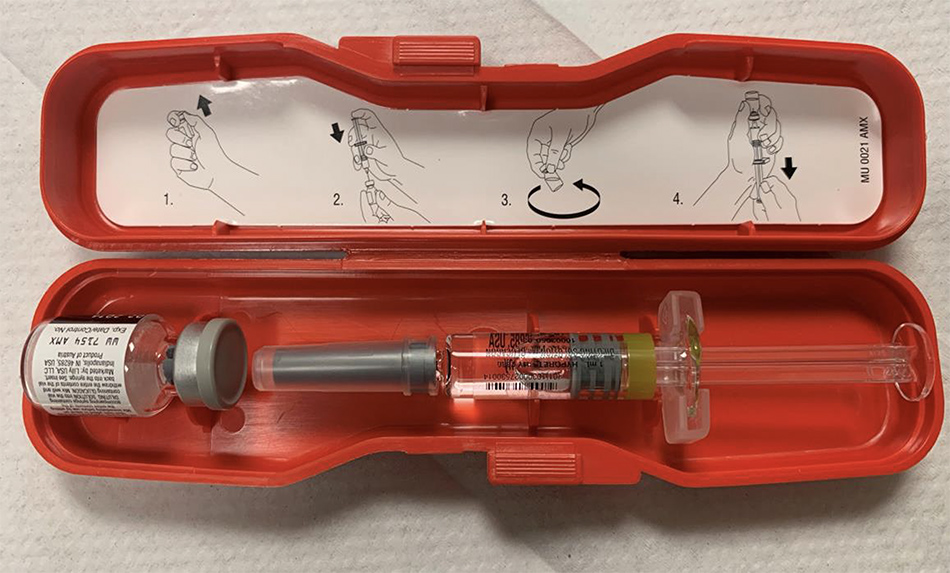Pediatric Diabetes
Hypoglycemia (low blood glucose)
Symptoms of hypoglycemia in children
If your blood glucose is low, you may feel some of the following symptoms of hypoglycemia:
- Shaking
- Fast heartbeat
- Sweating
- Anxious
- Dizziness
- Hunger
- Impaired vision
- Weakness/fatigue
- Headache
- Nervous or upset
Common causes of low blood glucose
- Too few carbohydrates
- Too much insulin
- Extra activity or exercise
Treating low blood glucose
You should treat blood glucose less than 70 mg/dL. Here’s how:
- Tell someone you feel low and test blood glucose.
- If blood glucose is 70 mg/dL or less, treat by eating or drinking fast-acting carbohydrate. (Refer to table in “Pediatric Diabetes Low Blood Glucose Treatment” handout for correct amount of fast-acting carbohydrate based on age).
- If blood glucose is 50 mg/dL or less, take DOUBLE the amount of fast-acting carbohydrate.
- Wait 15 minutes then re-check blood glucose. Repeat step 2 if blood glucose is 70 mg/dL or less.
Never give food to a person who is unconscious/unresponsive (will not wake up / does not respond) from hypoglycemia. If the person is unconscious/ unresponsive, give Baqsimi or Glucagon and call 9-1-1.
Pediatric diabetes low blood glucose treatment
Fast-acting carbohydrates for low blood glucose (less than 70mg/dL) based on age:
| Age | Carbohydrate (grams) |
Juice (ounces) |
Sugar* (number of teaspoons, cubes or packets) |
Glucose tabs |
| Younger than 16 months | 4 | 1 | 1 | |
| 16 months to 6 years | 8 | 2 | 2 | 2** |
| 7 to 10 years | 12 | 3 | 3 | 3 |
| 11 years and older | 16 | 4 | 4 | 4 |
For blood glucose 50mg/dL or less, DOUBLE the amount of recommended treatment.
*Sugar can easily be dissolved in water
**Only give glucose tablets to children older than 4 years old who can safely chew and swallow tablets
These guidelines are recommendations for the treatment of hypoglycemia. Please consult with your endocrinologist as needed.
Glucagon
A person needs Glucagon when they are having a severely low blood glucose AND they are unresponsive or unconscious, having a seizure, and/or are unable to take fast-acting carbohydrate like juice, sugar, icing, or honey by mouth. You should always have Glucagon with you.
Directions for use:
- Remove the flip-off seal from the bottle of Glucagon. Wipe rubber stopper on the bottle with an alcohol swab.
- Remove the needle protector from the syringe and inject the entire contents of the syringe into the bottle of Remove the syringe from the bottle.
- Swirl bottle gently until Glucagon dissolves completely. The solution should be clear and water-like in consistency.
- The usual dose is 1 mg. For children weighing less than 44 lbs., give ½ mg (0.5 mg mark on syringe). There is no danger of overdose with Glucagon.
- Inject immediately into muscle: buttock, thigh, or arm.
- Glucagon may cause vomiting. Turn patient on his or her side to prevent choking.
- Call 9-1-1 immediately after giving Glucagon.

Nasal Glucagon: BAQSIMI
(for people ages 4 years and older)
BAQSIMI is a nasal glucagon (sprayed through the nose) that can be used to treat severe low blood glucose (hypoglycemia).
Directions for use
- Do not remove the shrink wrap until you are using BAQSIMI. Remove shrink wrap by pulling on the red stripe.
- Open the lid and remove the device from the tube.
- Hold the device between your fingers and thumb.
- Insert tip into one nostril until finger(s) touch the outside of the nose.
- Push plunger all the way in. Dose is complete when the green line disappears.
Note – each device contains one dose (one dose is 3 mg). This dose is the same for all people ages 4 years and above.
For a “how-to” video, visit the BAQSIMI site
After giving BAQSIMI
- Call 9-1-1 right away.
- Turn the person on their side.
- If the person does not respond after 15 minutes, another dose may be given, if another device is available.
- The person receiving BAQSIMI should eat as soon as possible. When they can safely swallow, give the person a fast-acting source of sugar.
Important information to know
- Store at temperatures up to 86°F (30°C) in the shrink-wrapped tube provided. Do not refrigerate or freeze.
- Do not remove the shrink wrap or open the tube until you are ready to use it.
- Do not push the plunger or test BAQSIMI before you are ready to use it.
- BAQSIMI contains 1 dose of glucagon nasal powder and cannot be reused.
For more information visit manufacturer’s website: www.baqsimi.com

